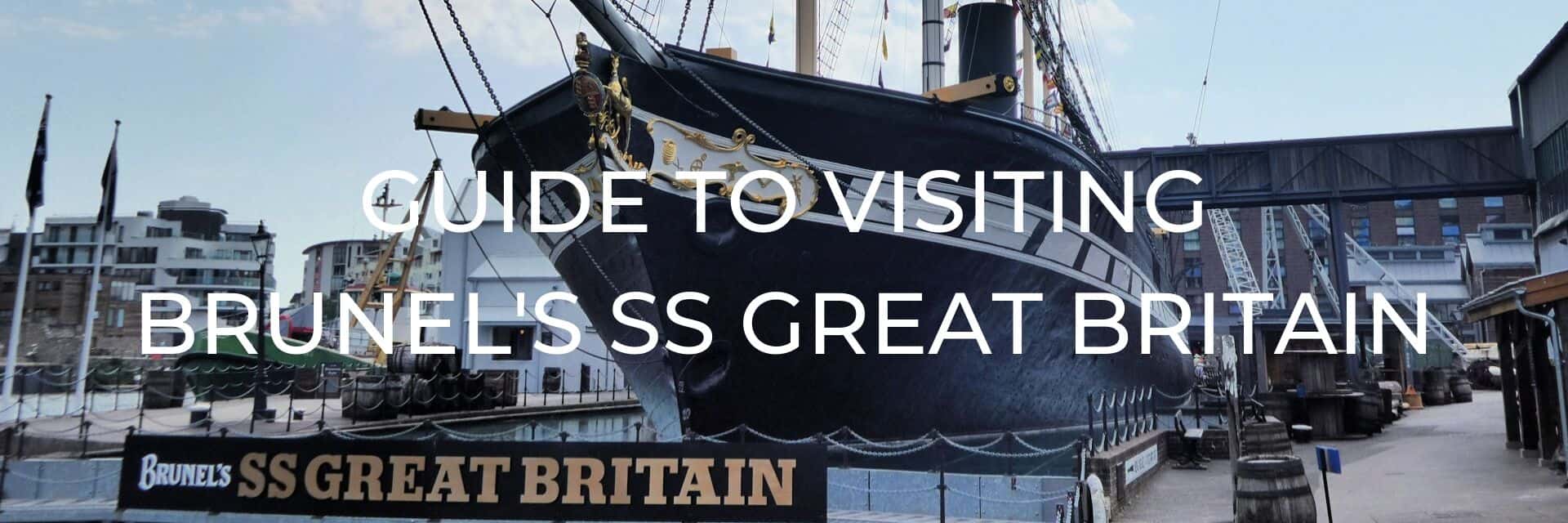
The SS Great Britain was the first ship to adopt both an iron hull and a screw propellor and forever changed the way ships were designed when it launched in 1843. By far the biggest ship ever to be launched until then, she was built for the transatlantic route from Bristol to New York. The ship is one of many of Isambard Kingdom Brunel’s contributions to human progress and engineering in the 1800s and stands today as a monument to one of the great engineer’s achievements.
Want to save this for later? Click the Pinterest button on the left for a pinnable image!
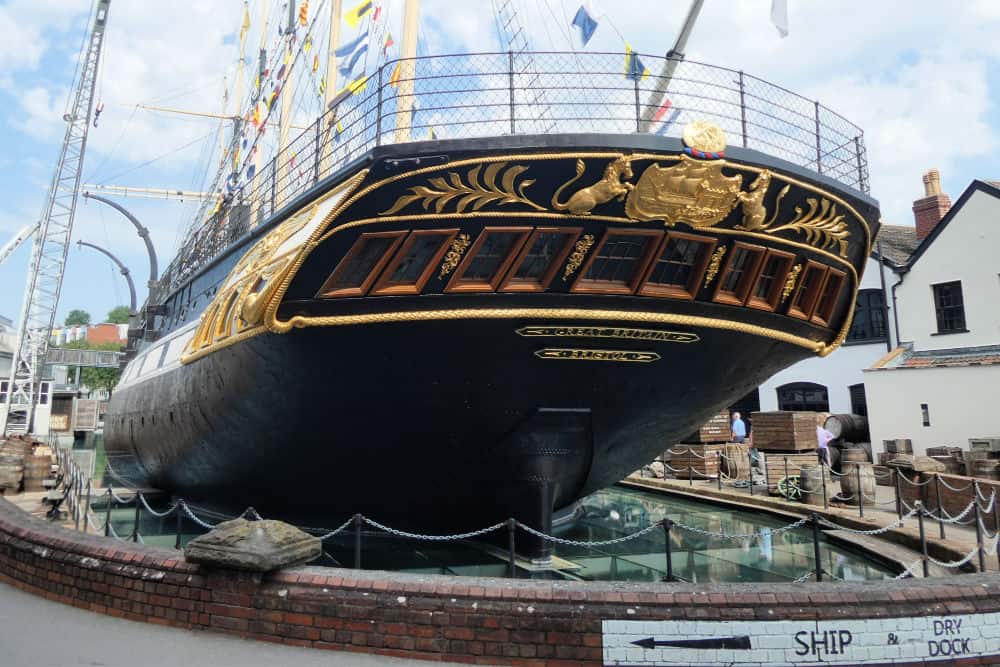
This post may contain affiliate links. Please read our full disclosure policy here.
SS Great Britain was one of Isambard Kingdom Brunel’s most famous engineering achievements. The largest ship ever built, she also incorporated the latest in ship design, being both made of iron and powered by a screw propeller. The adoption of an iron hull came from a visit to Bristol by the ship Rainbow, then the largest iron-hulled ship afloat. Brunel’s associates were dispatched to travel on the ship and were quickly converted to the benefits of building a ship from iron instead of wood.
Chance knocked for a second time when the SS Archimedes, the first screw-propelled steamship, also visited Bristol and attracted Brunel’s interest. Brunel was lent the SS Archimedes for him to use as a test-bed and they used the time to prove that screw propulsion was the best solution.
The launch of the ship was such an occasion that it was attended by Prince Albert who travelled to Bristol on Brunel’s Great Western Railway. The Royal Train was even conducted by Brunel himself. The launch is reported to have gone less than smoothly when the bottle of champagne swung by Clarissa Miles missed the ship and it is reported by some that Prince Albert himself hurled a second bottle which successfully smashed against the hull. The newly launched ship was over 100 ft (30 m) longer and 1,000 tons heavier than anything launched before.
The ship had a long and interesting history, firstly working as it was designed crossing the Atlantic as a passenger ship. In 1852 she was adapted to be an emigrant transport ship transporting people as far afield as Australia. Her final commercial use was as a cargo ship, during which time she was badly damaged by a storm and sought shelter in the Falkland Islands.
Deciding the repair costs were prohibitive, the ship was used by locals in the Falklands before eventually being scuttled. This could have been the end of the story, but thankfully she was eventually rescued, brought back to Bristol and restored to her former glory.
HIGHLIGHTS OF THE SS GREAT BRITAIN
SS Great Britain is much more than just a ship to visit, impressive though the ship is. There is also the Being Brunel exhibition with lots of information about the engineer and the whole dockyard is authentically decorated.
There isn’t a guided route through the museum, so be sure to check the map to be certain you don’t miss anything you really want to see.
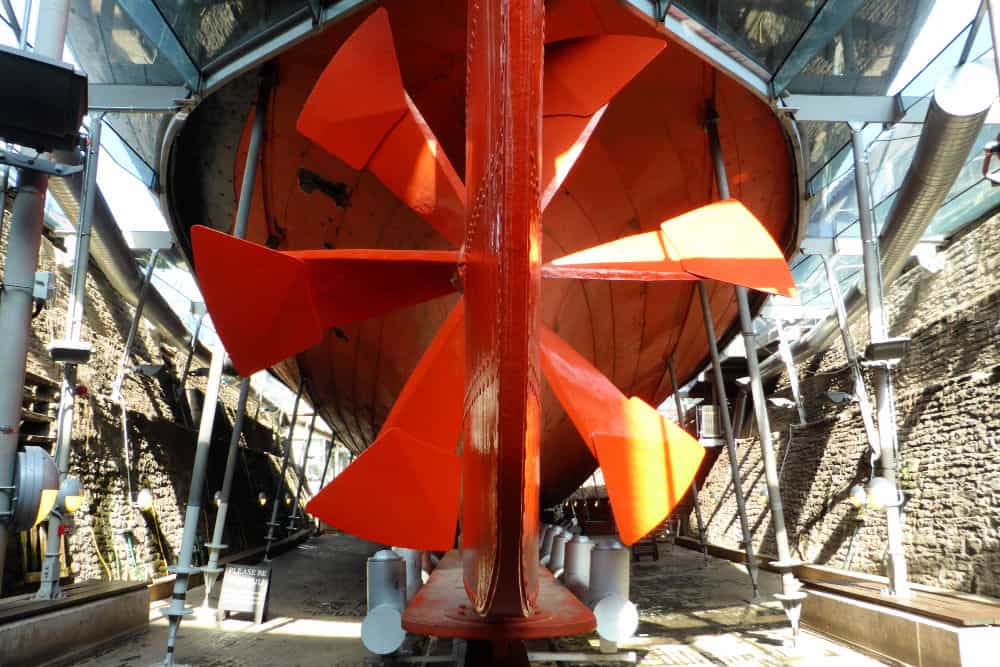
DRY DOCK
Descending into the dry dock you get to see the unrestored hull of the SS Great Britain. While in decent condition at first glance, you’ll soon see many holes that would render the ship unseaworthy in an instant.
What is intact however is the giant screw propeller the ship is famous for and of course, those holes reveal the ship is made of iron, it’s other famous attribute. You can see the ship above the waterline above you through the glass ceiling that keeps a small layer of water above it to make it look like the ship is afloat from the dockyard.
The dry dock itself was built in 1839 and is where the SS Great Britain was constructed, so it really has come home. The other, slightly scary, thing to notice is the giant caisson at the bow end that is the only thing keeping out all that water from the dry dock!
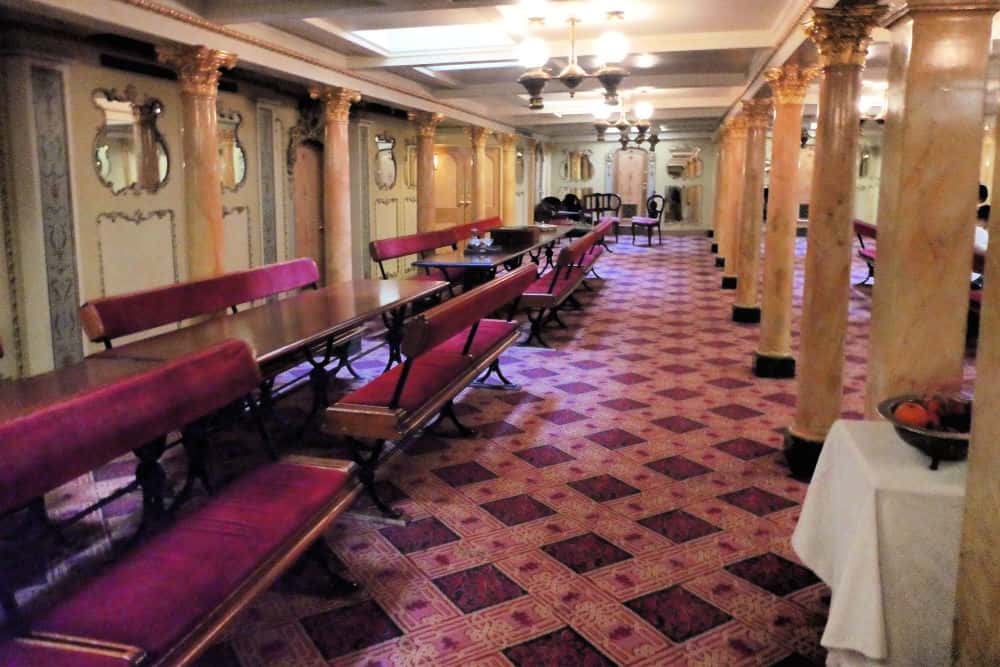
INSIDE AND ABOVE DECKS
Boarding the ship you are free to explore at your leisure. There are many areas of the ship to see and many are mocked up with mannequins and props to show how they may have looked when the ship was transporting passengers. Segregation is in evidence by the different classes of travel and a line painted on the deck which forbade non-first-class passengers from being on that part of the deck.
Descending below decks you will witness various cabins of different classes and sizes often complete with “passengers”. From plain and cramped areas with little or no privacy to much plusher and more luxurious cabins, though none meet modern cruising comforts of course.
You can also visit the engine rooms of the ship and even see into unrestored areas where you can see the many holes in the hull with daylight pouring through them. Finally, you can visit the extravagant dining and ballroom area with plush seating and live music for the first-class passengers to enjoy.
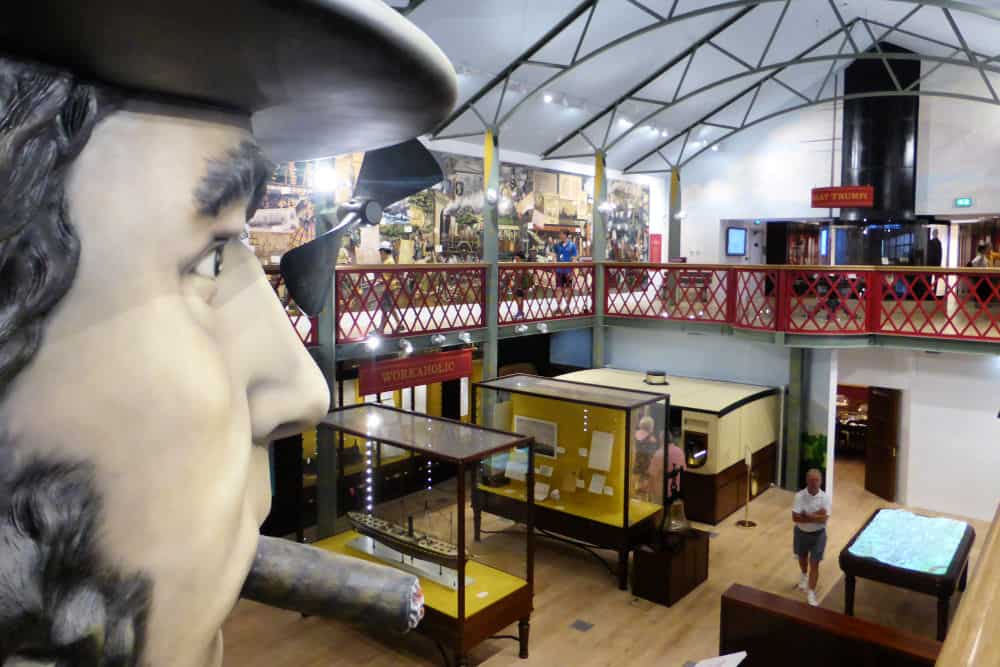
BEING BRUNEL
Being Brunel is an exhibition dedicated to the designer of the SS Great Britain and the man who has been voted the greatest Briton who ever lived, Isambard Kingdom Brunel. To say he had an impact on the UK is an understatement and you can still see many of his designs and engineering works being used into modern times.
Entering the exhibition you’ll walk through Brunel’s dining room from his London home known as the Shakespeare room. You’ll then enter the main exhibition hall and encounter an enormous 3D bust of Brunel dominating the room. The image is taken from the famous photo of Brunel standing in front of enormous steel chains that became his iconic image. Around the room are many exhibits showing some of his many projects. From the successful to the unsuccessful, many of his engineering attempts are documented.
After an enormous mural along the wall which shows graphically many of his engineering projects, you enter a cinema to take an imagined glimpse into the mind of the great engineer with some of his projects “seen” through his eyes. The last part of the museum is the Dock Office where a recreation of his London and Bristol offices shows the conditions he would have worked in as he designed the SS Great Britain and other engineering marvels.
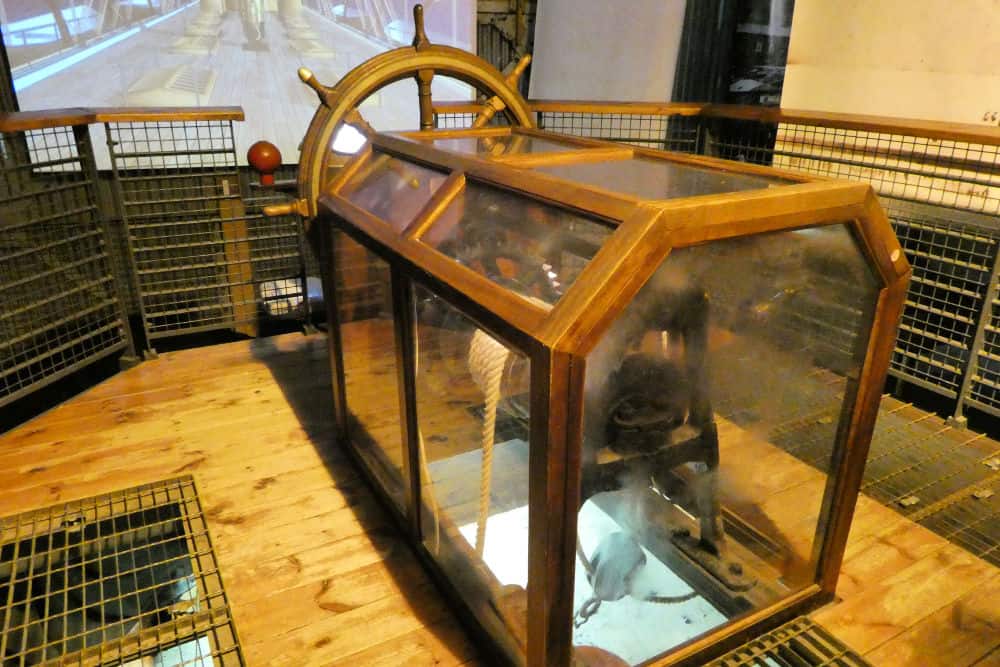
DOCKYARD MUSEUM
The Dockyard Museum takes visitors through four time-zones as they explore the SS Great Britains fascinating life story. From the salvaging of the ship in 1970 from its watery grave you’ll head back in time to the 1880s when the ship was converted from steam to a Windjammer and made several journies to San Francisco.
Further back, to the 1850s, the ship made 32 voyages to Australia and elsewhere, taking emigrants around the world. Then you return to the ship’s time as an ocean liner, it’s originally designed purpose and finally back to its launch in 1843 when thousands crowded on the dockside to witness the biggest ship of its day being launched.
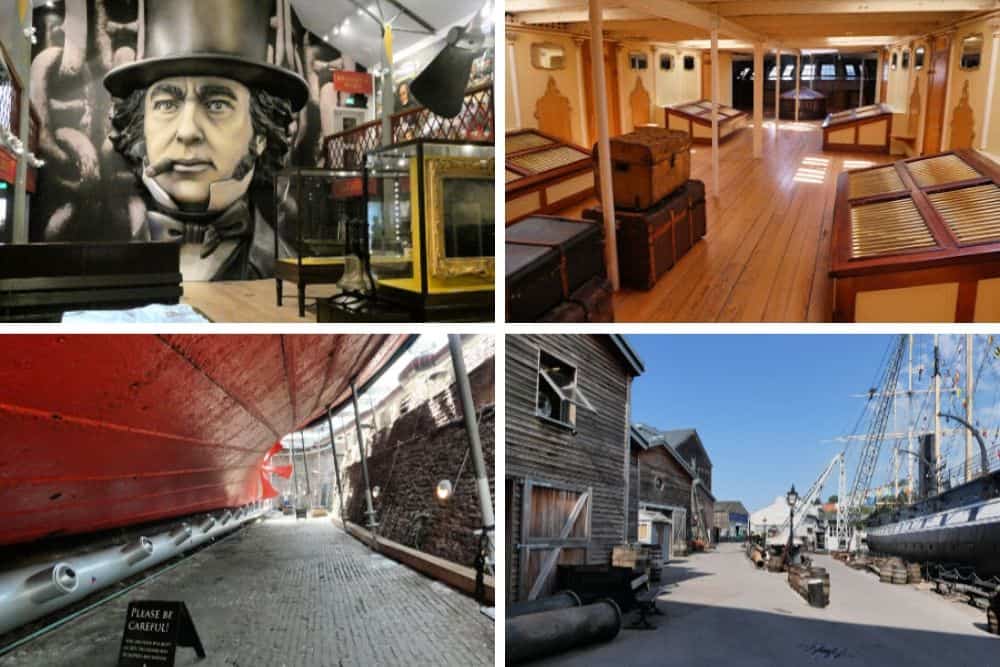
PLAN YOUR VISIT TO THE SS GREAT BRITAIN
Information last updated September 2019
HOW TO GET THERE
The SS Great Britain can be found at Great Western Dockyard, Gas Ferry Road, Bristol, BS1 6TY.
The nearest station is Bristol Temple Meads (Great Western Mainline), however, it is a 27-minute walk away, so you might want to take a bus, ferry or taxi to SS Great Britain. There is a ferry stop right at the ship for both the Cross-Harbour Ferry from Hanover Quay and the Bristol Ferry Boats that serve many points around the city, including the railway station.
Parking is available next to the ship which is run by Bristol City Council. Parking is £1 per hour with a minimum of two hours and a maximum of five, but visitors to SS Great Britain can pay just £2 for up to five hours by redeeming the difference at the visitor centre.
From the centre of Bristol, the SS Great Britain is about a twelve-minute walk, if you take the Cross-Harbour Ferry.
HELPFUL LINK:
- If you need an app that will navigate you around whether walking, driving or using public transport and even works offline then click for a guide about how to use Here WeGo.
OPENING HOURS
Opening hours are 1000-1630 every day except for the 24th and 25th December and the second Monday in January. Opening hours are extended to 1800 in the summer. Last entry is one hour before closing.
As much of the attraction is indoors, any time of year is a good time to visit and it could be a good place to visit on a rainy or cold day. The dry dock can be quite hot due to the humidity levels keeping the ship in good condition, so on warm days, we suggest you do this as early as possible. We would recommend you allow at least two to three hours to fully explore the ship as well as the dockyard museum and Being Brunel.
HOW TO BUY TICKETS & SAVE MONEY ON ADMISSION
Basic admission prices are £17 for adults, £10 for children 5-16 years, £15 for over 65s and student visitors. One carer per disabled visitor can visit for free. You can save 5% by booking online in advance
ACCESSIBILITY
Despite being such an old ship, the entire ship, Being Brunel museum, dry dock and dockyard are wheelchair accessible. You can even avoid the cobbles outside the entrance by entering through the adjacent Harbourside Kitchen cafe.
For full accessibility details please visit the SS Great Britain Accessibility page.
IS THE SS GREAT BRITAIN WORTH THE VISIT?
For fans of Isambard Kingdom Brunel or those with a keen interest in seafaring history, the SS Great Britain is an excellent place to visit. The ship has been amazingly restored and looks like it could set sail at a moments notice until you go into the dry dock and see that water would soon flood in that is!
The museum about Brunel is very interesting and covers many of this legendary engineer’s projects and achievements, as well as some less successful projects like the atmospheric railway or building the Great Western Railway to broad gauge.
The rest of the dockyard has been dressed to look as much like it would have around the time the ship was constructed and really helps to set the scene of the importance of this historic ship.
See what others think of this attraction on Trip Advisor.
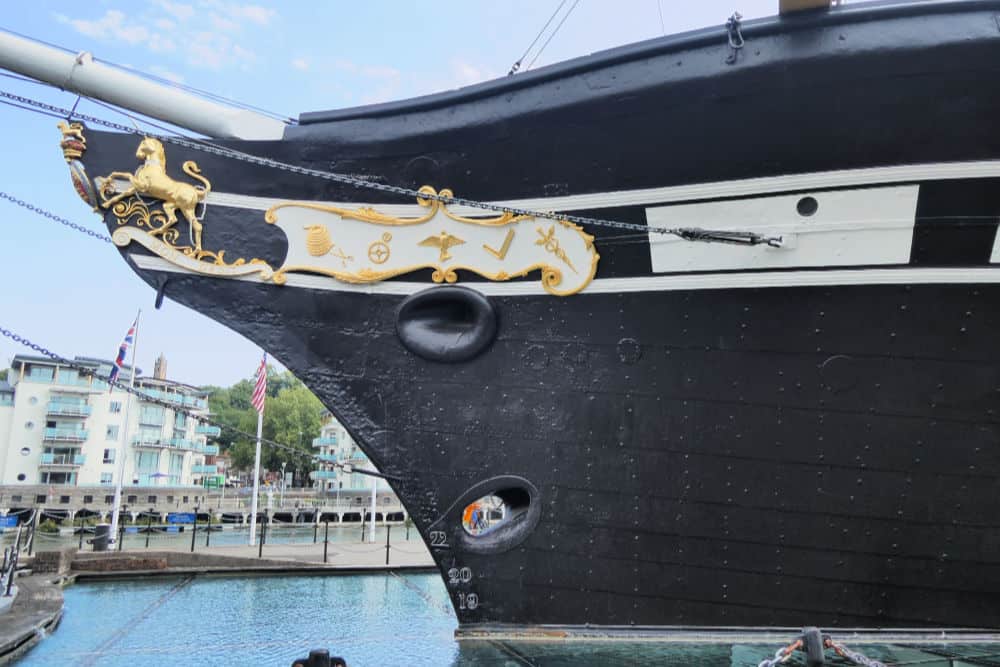
ADD TO YOUR BRISTOL ITINERARY
Originally known as Brycgstow from the Old English “place at the bridge”, Bristol has existed for over a thousand years. With a rich history including major shipbuilding and aerospace industries as well as being synonymous with famous names from Brunel to Banksy, there is plenty to keep visitors busy. Here are a few choice selections to whet your appetite.
-
Another of Isambard Kingdom Brunel’s achievements, Clifton Suspension Bridge has spanned the Avon Gorge for 1864 and is one of Bristol’s most famous sights.
-
Bristol Museum and Art Gallery has fine collections of many aspects of human endeavour as well as the natural world. It is also the home of Banksy’s famous Fallen Angel statue.
-
Aiming to inspire by encouraging people to ask questions, We The Curious is a science museum and planetarium which wants you to interact with the exhibits and keep asking questions.
-
In a former transit shed which gives it its name, M Shed tells the story of Bristol. You can also find working examples of cranes, boats and trains that were used when the port was active.
-
Take in some medieval architecture in England’s only hall church cathedral. Bristol Cathedral has been a place of worship since the 12th-century.
RELATED ATTRACTIONS IN THE UK
The UK’s rich maritime and engineering history has given the country a fantastic legacy of amazing attractions. Here are a few you might want to consider visiting:
- View more amazing engineering at Aerospace Bristol birthplace of the iconic Concorde. The museum has many exhibits celebrating Bristol’s role in aviation history.
- Explore HMS Belfast, a real warship that served in World War II and is one of only three remaining warships that served on D-Day in 1944.
- The Royal Yacht Britannia served for 43 years. Travelling a million miles around the globe it served as an advert for the United Kingdom, being used for many trade events, as well as HM the Queen’s personal yacht.
- Three more historic ships can be explored at the Historic Dockyard Chatham. It was a Royal Navy base for over 400 years and today has three historic ships to explore as well as many exhibitions explaining the history of the dockyard.
- More historic ships can be seen at Portsmouth Historic Dockyard including the oldest naval ship still in commission HMS Victory and Henry VIII flagship the Mary Rose which sank in 1545 and was raised from the seabed in 1982.
Want to save this for later? Click the Pinterest button on the left for a pinnable image!
RESOURCES | PLAN YOUR TRIP TO BRISTOL
To book flights, rental cars, accommodations, and activities for your trip, please check out our recommended travel providers, favourite apps and websites.
Some of the links in the post above are affiliate links. This means if you click on the link and purchase the item, we will receive an affiliate commission but this does not affect the price to you. Please read our full disclosure policy here.





